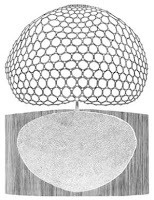 Steven Weinberg visiting the ATLAS cavern accompanied by Peter Jenni see: Steven Weinberg visits CERN
Steven Weinberg visiting the ATLAS cavern accompanied by Peter Jenni see: Steven Weinberg visits CERN So the understanding "is" that as Steven portrays as been spoken of before by Clifford or by associates in proximity, that his views reveal the status from which the top down has located this experimental validation as to what is self evidential with regard to the Aristotelian arch. The QGP.
For those who understand what I am saying, will be too understand the unification process of the deductive/inductive approach toward thinking in this exercise.
Unfortunately, the repair necessitates a partial warm-up of both sectors. This involves the end sub-sector being warmed to room temperature, while the adjacent sub-sector "floats" in temperature and the remainder of the sector is kept at 80 K. As the leak is from the helium circuit to the insulating vacuum, the repair work will have no impact on the vacuum in the beam pipe. However the intervention will have an impact on the schedule for the restart. It is now foreseen that the LHC will be closed and ready for beam injection by mid-November.See: The latest from the LHCBold added for emphasis by me.
So indeed there is the physical apparatus for experimentation in effective methods to discernment that needs physical correction and in no ways speaks to the holes per say, but rely on the understanding that such a "theoretical concern" is by what is revealed in extremities of cold and heat, that can be correlated same.
One of my interests is to what is the "loss of energy" that we might understand where it has gone, that we say "dimensional significance" to explain this loss fully understanding the quantity and energy value first assign the experiment.
So how and what is this loss attributed too?
Some thinking here in terms of "Dirac's hole" to think that if "i" is introduced in the axiom(matrice) then it presents the geometrical necessity of movement in non euclidean thinking, as to movement of dynamical processes?
 Accretion Disk
Accretion DiskSo I speculated as to the nature of "continuity of expression" that arises from my cosmological view of "birth of this universe." To say that in this example, this universe was produced "from a hole" that allowed transmission of energy to move "through a conduit" to this side of the universe in expression. Just as dimensional relation may be perceived of, as in "energy loss" from it's original state as in the LHC calculations.

Our work is about comparing the data we collect in the STAR detector with modern calculations, so that we can write down equations on paper that exactly describe how the quark-gluon plasma behaves," says Jerome Lauret from Brookhaven National Laboratory. "One of the most important assumptions we've made is that, for very intense collisions, the quark-gluon plasma behaves according to hydrodynamic calculations in which the matter is like a liquid that flows with no viscosity whatsoever."
Proving that under certain conditions the quark-gluon plasma behaves according to such calculations is an exciting discovery for physicists, as it brings them a little closer to understanding how matter behaves at very small scales. But the challenge remains to determine the properties of the plasma under other conditions.
"We want to measure when the quark-gluon plasma behaves like a perfect fluid with zero viscosity, and when it doesn't," says Lauret. "When it doesn't match our calculations, what parameters do we have to change? If we can put everything together, we might have a model that reproduces everything we see in our detector." See:Probing the Perfect Liquid with the STAR Grid
So, fragmented images arise in my mind as to the "collision process in that moment" to reveal the continuance of the universe "from black holes." These local views toward reductionist methods as in "top down" toward located experiential validation point is "self evident," as to explain, where this process started.
So questions arise as to what is fundamental about energy that it could be in one state and exist as a "momentum expressive view" as to changing to this universe in relation? It means that it had to exist "prior." How many ways can it then be expressed from and about, that it could exist in the one schematic form, to become, all that it is afterward in physical form?
Without this intent, it could have not manifested as otherwise, and is lost to all probable accounting, so that there was no way to ascertain that humanity could exist this way as it does, or, that the universe could be as it is.
Dimensional significance is related to architectural geometry realized as this energy changes "to form" yet in uncertainty as to say how it will become this way?
This does not lesson my views on what exists first "as a pattern" could be surmised to be energy in it's first form of imagery. To have it become, and in this way ascertain to believe, that we are indeed in control of our destiny as to say that the "formative images of mind" are therefor patterns for the future.
Indicative of "societal values" by our choosing.















